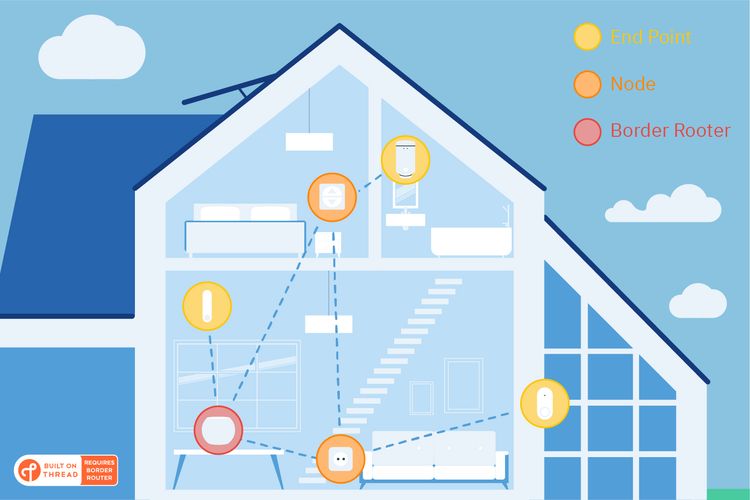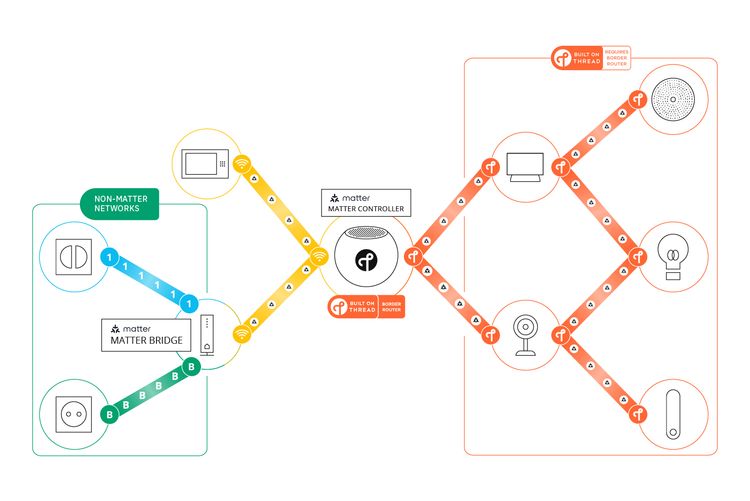In 2019, the smart home world discovered Matter. Described as a connectivity standard for simplifying automation between smart home and Internet of things devices, many questions still surround the Matter project. How does it work? What needs does it meet? What will change in the smart home? If you’re looking to get the best results from the latest smart technology, or just need to know how it all works, you’ll find the answers in this article co-written with expert Benoît Bourdon, Senior Product Manager at Netatmo.
What problem is Matter trying to solve?
A profusion of manufacturer-initiated technologies
The world of the Smart Home and connected objects is still young but already vast, complex and quite varied in terms of technology. With a number of different standards in existence, each company has relied on its own skills, the technologies available to its teams and its own choices to develop ranges of smart connected products. Over the years, numerous communication technologies have emerged in the world of the IoT (Internet of Things): Z-wave, IO, Bluetooth, Wi-Fi, Zigbee, Thread, LoRaWan, etc.
Each of these technologies has its advantages, disadvantages, aficionados and detractors, but they all respond to varied and specific technological challenges:
- Battery-powered devices require energy-efficient communication technologies to preserve battery life.
- Some types of device only need to exchange very low volumes of data (for example, turning on a light requires very little information), while others work with high volumes of data (like video streams).
- Some devices are stand-alone, while others must be part of a network of smart objects (also known as smart connected things). For example, a camera may work on its own, whereas a switch is usually part of a set.
- Range, whether in relation to an Internet access point or to other smart objects, also has an impact on technology choices:
- Some technologies are ideal for longer ranges, but use more energy.
- Others are highly effective for short distances, but need to be repeated by other devices to ensure optimum coverage.
- Finally, of course, the cost of manufacturing the object is an important criterion. It’s impossible to produce one device that meets all requirements at a reasonable cost.
A wide range of companies are now manufacturing objects which work on different platforms. There are compatibility and security concerns as users are faced with a varied and complex list of devices that are sometimes difficult to understand, and often have to be combined with different ecosystems (Apple Homekit, Google Home, Amazon Alexa and so on).
Voice assistants: Highly independent ecosystems
Voice assistants and other controllers allow smart objects to be grouped together in a single ecosystem, as well as enabling interaction between devices. However, each ecosystem has developed its own method of interconnection with products of different brands:
- On the one hand, Apple Homekit uses the HAP specification, which operates locally and has an impact on hardware choices.
- On the other hand, Google Home, Alexa and SmartThings have opted for Cloud to Cloud interactions, requiring the development of APIs specific to each one.
- Other controllers offer local ZigBee3.0 integrations, which work with Zigbee objects and require testing and sometimes costly adaptations.
- Finally, some controllers, often supplied by distributors, combine these different communication standards, which sometimes makes things more complicated for the end user.
So a manufacturer that wants to be compatible with all these ecosystems would have to master a long list of technologies in-house, and develop as many compatibilities for each new device as there are ecosystems. This represents a substantial additional cost in terms of time and investment, for an experience that won’t always be able to meet the future challenges of the smart home.
New uses
Faced with the challenges of today’s world, the connected home continues to evolve for the benefit of users. Indeed, beyond the “gadget” aspect, smart connected products will complement each other and interact to simplify and improve our daily lives at home:
- Good shutter management according to sunshine and indoor temperature will result in substantial energy savings, both in summer and winter.
- Better integration between window opening detection and radiator control will lead to significant savings.
- If excessively high CO2 or humidity levels are detected, a window will open automatically or a mechanical ventilation system will start up to improve indoor air quality.
Unfortunately, the abundance of devices and ecosystems on offer makes it hard to transition smoothly from a connected home to a smart home. Today, it’s difficult for users to ensure that a new device integrates seamlessly with the other smart objects in their home.
A response to this diversity and technological complexity
Faced with this situation, Smart Home companies have decided to join forces within a single organisation: the Connectivity Standard Alliance (CSA), whose aim is to set a standard that will free the market from all these obstacles, reassure consumers and make their lives easier.
The aim is to facilitate interaction, simplify installation and ensure a high level of security for future smart objects, while remaining backward compatible.
What is MATTER?
To clarify what Matter is, let’s draw a parallel with the world of language and human communication.
Effective communication is based on:
- A language: an alphabet, a vocabulary and a common grammar that enable us to understand each other. So anyone who knows a language will understand the message as long as it follows an established set of rules.
- Communication channels that convey this language. For example, we can exchange information verbally, in writing, by e-mail or SMS, or via a videoconferencing system...
The Matter standard could be seen as a language spoken by smart objects.
Matter works in exactly the same way:
- By defining a language and grammar enabling various devices to exchange orders and information, all written and secured in the same way: this is known as the application layer.
- By defining communication channels to carry this language: the transport layer.
What’s more, Matter is designed to integrate existing technologies by means of “bridges”, which are “translators” through which the Matter language is transmitted to various other languages that can use other communication channels.
How does Matter enable smart objects to interact?
To understand each other, smart connected things must first be authorised to communicate. Adding an object to a Matter network initiates a number of exchanges that guarantee that the device is officially Matter-compatible and is made by a certified company. What’s more, this exchange of certificates enables totally secure communications within a home network.
It also involves structuring the information that passes between smart objects. Drafting the standard then consists in defining and describing the types of products available within it at a given time for a given version.
In addition, for all types of device, the following things have to be described:
- the expected features and attributes,
- the types of orders they can send or receive,
- and, of course, technical formats for exchangeable information that are understood by all.
To use the technical terms described in the standard, all this information is called a cluster. So we talk about cluster HVAC and cluster lighting, for example, within which classification identifiers will be defined: the features, attributes, commands, events, data types and state descriptions...
Communication channels
This common language exchanged by smart objects is able to spread through different communication channels.
As there is no single solution that meets all needs, Matter relies on 3 complementary communication channels:
- Wi-Fi,
- Ethernet,
- Thread.
These 3 channels are IP-based protocols. The notion of an IP address and the associated protocols are extremely widespread and relatively commonplace for software developers. A final communication channel is defined in the standard: Bluetooth Low Energy (or BLE). For Matter, it’s dedicated solely to commissioning, i.e. the initial installation of the product.
Wi-Fi
Wi-Fi, which stands for “Wireless Fidelity”, is well known to everyone as it’s extremely widespread, found in all homes with a router. It’s a wireless network supplied by all Internet service providers, whose connection methods are mastered by everyone involved, from manufacturing companies to users, so it seemed like an obvious choice. However, Wi-Fi does have one significant drawback. It can be quite power-hungry, and is not always suitable for battery-powered devices. What’s more, the range of Wi-Fi may not be enough for larger homes. To solve this problem, which is not confined to connected objects, ISPs generally offer packages to extend coverage.
Ethernet
Ethernet is a wired communication protocol. Like Wi-Fi, it’s a communication channel that’s very much in evidence in our homes, as it’s available for all historical connected products, such as routers, televisions and computers. Its reliability and speed, superior to that of wireless connections, are an advantage for devices that work by transferring large volumes of data, such as surveillance cameras or televisions. However, although no apps are required, a wired connection can be a more complicated experience for the user, who has to set up cables in their home instead of installing an app.
Thread
In use since 2015, this is a low-latency, low-power mesh network. So this protocol complements Wi-Fi particularly well:
- Low power consumption: it can be used to manage battery-powered devices while maximising battery life.
- Low latency: this will enable rapid exchanges between objects.
- Meshed: each smart object has a relatively small range but will relay the signal to neighbouring Thread products, forming the links in a chain to achieve a maximum range.
Each of these meshes is called a node, and there are 2 types of node in a Thread network:
- Thread nodes: nodes with enough power to repeat received signals.
- Thread end devices: nodes that can’t retransmit signals, because they’re battery-powered and don’t have enough power to do so.
While devices in the same Thread network can easily communicate with each other, they need a dedicated product, called a Border Router, to act as a translator and enable them to interact with smart objects over Wi-Fi or Ethernet.
The bridge concept
As we explained earlier, manufacturers didn’t wait for Matter to design connected objects, and have been investing for years in a variety of technologies to meet their needs. This type of investment is quite costly: upskilling and team development, board design, chip stocking, etc. All companies have a large number of products already on the market, already installed and connected. So you can see why it’s not easy, straightforward or even relevant for every manufacturer to switch their entire offering to one of Matter’s transport layers. So, to encourage manufacturers to adopt the standard and make life easier for users, the concept of a bridge was created. A bridge is a translator that connects Matter’s world and the manufacturer’s world. Thanks to this bridge, existing devices can interact with the Matter network.
Conclusion on Matter
Matter is revolutionising the connected home. On the one hand, manufacturers will be able to focus on the user experience rather than on integrating their technology into ecosystems, and on the other, customers will be able to create interactions, automations and scenarios much more easily. What’s more, it’s highly likely that this standard will enable the development of numerous partnerships between companies, offering new ways to meet to emerging needs. The future is being written with Matter, ensuring that the connected home will become a truly smart home.


